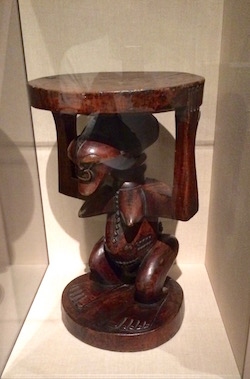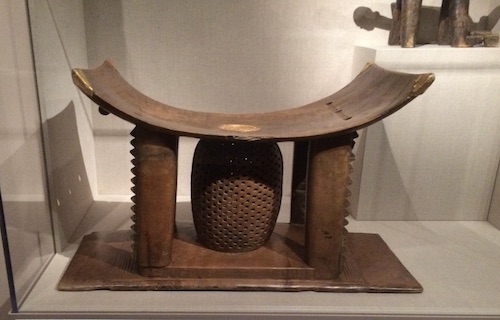Most scholars of history, no matter who or what they claim as their cultural heritage, trust.
They trust facts validated by experts in their respective fields. Doubt and uncertainty are suspended in order to establish a knowledge base. The base is subsequently stacked with beliefs and research funded by interested groups.
Then this history behemoth is used to subdue challenges to its validity.
Much of my woodworking knowledge comes from the techniques, tools, and traditional thought that form the basis of the woodworking arts. It’s the way most people learn.
At the same time, I resist pressure to unquestionably comply with standards that were set by the dominant world culture. These standards evolved, largely, from the annals of the history of furniture design – and have nothing to do with me.
Thus, my history education is skewed, disordered, and unbalanced. What I learned in school provided no life-affirming cultural view as a black woman in this country or, for that matter, the world.
It did, however, present a point of view deeply stained by intolerance and avarice.
My purpose is to untwist those thoughts and facts used to minimize my cultural truths in the so-called “civilized” world.
Whose history is it anyway?
That’s just one of the questions I ask myself.
Historic examples of traditional furniture making or woodworking techniques are held as the standard de rigueur we are asked to uphold.
I don’t have the same appreciation, as an example, for a Queen Anne style chair or federal style table as other woodworkers. There is an appreciation; it’s just not the same.
Must I hold myself to those rules to attain or maintain my status as a woodworker? Is that knowledge even necessary? Do I need to pick up anyone else’s rulebook on how to be a woodworker?
I do not believe that replication of an 18th century chair in my wood shop is a true measure of my skills.
I’ve been dealing with limited information
My woodworking influences are innate and already borne from ancient African teachers not recognized, in a conventional sense, by world culture.
“Never limit yourself because of others’ limited imagination; never limit others because of your own limited imagination.” – Mae Jemison
I cannot cast aside the creative and spiritual acts that birthed the same furniture, sculpture, architecture and practical construction that are coveted by the world at large. I allow these items to speak to me in my work.
I hold awareness and appreciation of ubora (excellence in Swahili) that is apparent in the techniques of my cultural past.

Democratic Republic of Congo 1900s
Wood
Detroit Institute of Arts Museum
I can visit any major museum on earth and view those works of my ancestors in exhibition cases, staged displays, or coffee table sized books.
Of course, I love my outings to these magnificent galleries. They elevate my soul and serve as a wellspring of inspiration in my work.
It is distressing, however, that those very pieces of woodworking art are deemed primitive but at the same time worthy to exist in public and private collections and vaults.
Restitution as a step in the right direction
In France, the Restitution of African Cultural Heritage report was published in 2018 by Felwine Sarr, a Senegalese writer and Bénédicte Savoy, a French art historian.
The report detailed an assessment of public collections and a plan to restore at least significant items (many taken forcefully) of cultural heritage to their countries of origin.
French president, Emmanuel Macron, who commissioned the report, and the government recognized that France has a moral right of restitution of cultural heritage to its former French sub-Saharan colonies.
I agree.
Controversy, disagreements, and outright rejection followed the report. Its findings have been hesitantly received by museums in former colonizing countries, educational institutions, and private collections.
Great examples of heritage work in these places had been forcefully and violently “rescued” from their countries of origin and dispersed all over the world.
Justification for these acts ranged from outright refusal to recognize the ancestral artisans, craftsmen, and metalworkers as the originators of the heritage works to a tainted effort to “protect [these antiquities] for humanity”.
Yet, not one of these countries has ever had a significant cultural relationship with the creators of these cultural treasures:
- Belgium
- Spain
- France
- United Kingdom
- Germany
- Italy
- Japan
- The Netherlands
- Denmark
- Norway
- Portugal
- Russia
- United States
Their own possession, however, of African heritage works is defended to this very day.
Nonetheless, the ancient artisans of these works are not respected or acknowledged fully as the true originators of these works.
Doesn’t it speak volumes that countries actually “naturalize” non-human stolen art and spiritual treasures through possession?
Refusal to immediately recognize, as full citizens, the descendants of the artisan souls whose countries they once occupied or colonized is equally perplexing.
Student of the World or Student of Denial?
This taints the educational and vocational integrity for any credentialed student of the arts, architecture, furniture design, and history.
It is difficult to accept that a so-called good education can be built on a foundation of unquestioned acceptance of “facts” that have been rearranged and sanitized.
I believe anyone who deems him- or herself an educated person must critically evaluate what they have learned.
The logical conclusion is that much of what they have been taught or studied is based on conveniently “unknown” artisans, and contrived dates.
Skepticism of the intellectual abilities of said creators justified the bloody seizure of ancient works and the subsequent destruction of their creators.
Can one really build knowledge upon knowledge when it is based on a series of untruths made to justify the immoral acts perpetrated to gain possession of these treasures?
Can one be a critical thinker and at the same time accept recorded “history” not jiving with real, true history?
I believe that the cognitive dissonance surrounding the explanations of how these items are in the possession of those other than the originators should spark great debate.
It didn’t until now.
Using Power for Good
Discussions are taking place all over the globe. Some possessors pledged to return items. In a few cases, returns have already been made.
Some entities unabashedly proposed returning thousands of heritage objects on long-term loan to their countries of origin!
More commonly, attempts to turn words to action have been repelled by those desperate to enforce unconscionable claims.
The world is watching. So is the universe along with the homelands waiting for the treasures that are theirs by moral right and creation.
Aren’t the skilled wood crafts and other works of early African woodworkers worthy of imitation and teaching?
I believe these works should be studied, taught, and (finally) properly classified.
These techniques and objects d’art must be ranked alongside the other acknowledged standards in furniture design and woodworking today.

Mende Culture. Sierra Leone 1900s
Wood, pigment
Detroit Institute of Art Museum
The arts reflect the society that creates them. To the ancient Greeks, arete is yet another word for excellence and reaching one’s full potential.
This philosophical belief is evident through their temples, sculpture, and pottery – works that have been preserved and exalted for centuries.
I do respect the traditional standards, period styles, and characteristics as benchmarks in the history of traditional world craft.
That’s where I started my woodworking journey and I’m continuing to do so.
It is only a guide, however, not the path.
Now, I am using the study of my cultural heritage as a creative power source in the work shop.
Thankfully, some techniques and arts are still practiced in the motherland.
Since many skills were passed down through oral traditions and never “scripted” through history, certain details may be permanently lost.
Of course, the unconscionable looting of the motherland contributed to those losses.
It is imperative to develop ways to teach and preserve these arts, techniques, and their meaning for the future.
The challenge is to permanently return cultural heritage works to their countries of origin in order to reappraise the record for humanity.
As a result, national pride will spur efforts to classify these works, in their countries of origin, according to their culture and their history.
♥️ Shirley J
Updates:
- Dispelling Rumors, Greece Has Rejected the British Museum’s Offer to Return the Parthenon Marbles as a Long-Term Loan, Jo Lawson-Tancred, Artnet News, January 12, 2023
- Smithsonian Will Return Benin Bronzes in its Collection to Nigeria, article by Taylor Dafoe, Artnet News, March 8, 2022
- A Send-Off Exhibition of 179 Looted Objects in Hamburg Marks ‘the Beginning of the Return’ of Germany’s Benin Bronzes to Nigeria, Artnet News, article by Amah-Rose Abrams, December 17, 2021
- Italian Officials Have Returned Three Ancient Ceramics to Mexico, Observer, article by Helen Holmes, November 1, 2021
- The Return of Stolen African Artifacts by European Museums, Fairplanet, by Bob Koigi, April 39, 2020
- The Pope Has Put a Horse, a Bearded Man, and a Boy—All Marble Fragments Looted From the Parthenon—on a Trip Back to Greece, Artnet News, by Min Chen, March 7, 2023
- China Joins a Growing Number of Nations Demanding the British Museum Restitute Artifacts From Its Collection in the Wake of Widespread Thefts, Artnet News, by Sarah Cascone, August 28, 2023

